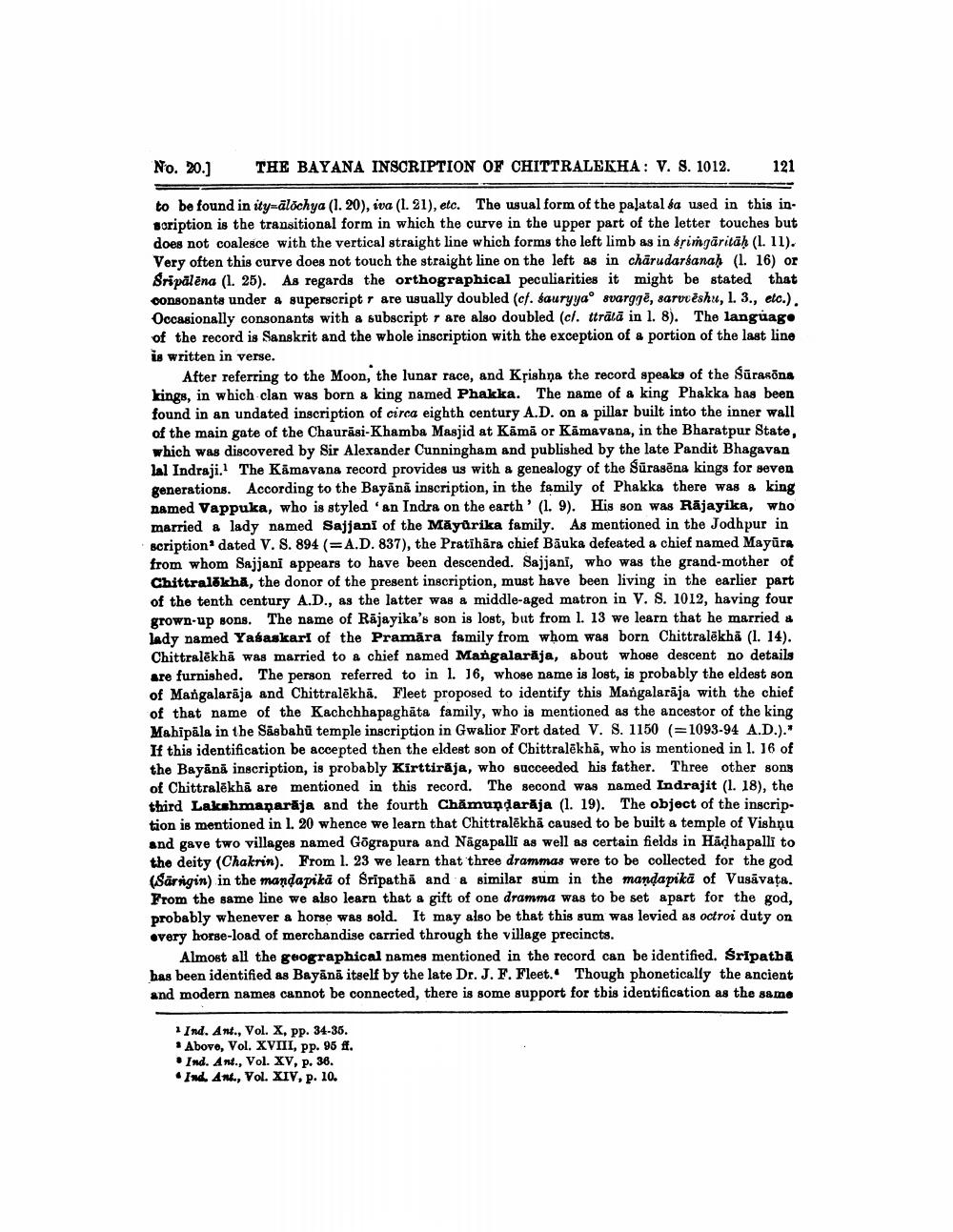________________
No. 20.)
THE BAYANA INSCRIPTION OF CHITTRALEKHA: V. S. 1012.
121
to be found in ity=ālöchya (1. 20), iva (1. 21), etc. The usual form of the palatal sa used in this inscription is the transitional form in which the curve in the upper part of the letter touches but does not coalesce with the vertical straight line which forms the left limb as in trimgaritäh (1. 11). Very often this curve does not touch the straight line on the left as in charudarsanah (1. 16) or Sripalēna (1. 25). As regards the orthographical peculiarities it might be stated that consonants under & superscript r are usually doubled (cf. sauryyao svargjë, sarvoéshu, 1. 3., etc.). Occasionally consonants with a subscript r are also doubled (cl. ttrālā in l. 8). The language of the record is Sanskrit and the whole inscription with the exception of a portion of the last line is written in verse.
After referring to the Moon, the lunar race, and Krishna the record speaks of the Sūrasons kings, in which clan was born a king named Phakka. The name of a king Phakka has been found in an undated inscription of circa eighth century A.D. on a pillar built into the inner wall of the main gate of the Chaurasi-Khamba Masjid at Kāmā or Kāmavana, in the Bharatpur State, which was discovered by Sir Alexander Cunningham and published by the late Pandit Bhagavan lal Indraji. The Kamavana record provides us with a genealogy of the Sūrasēna kings for seven generations. According to the Bayanā inscription, in the family of Phakka there was a king named Vappuka, who is styled 'an Indra on the earth' (1.9). His son was Rājayika, who married & lady named Sajjani of the Măyürika family. As mentioned in the Jodhpur in scription dated V. S. 894 (=A.D. 837), the Pratīhāra chief Bäuka defeated a chief named Mayūra from whom Sajjani appears to have been descended. Sajjani, who was the grand-mother of Chittralökhā, the donor of the present inscription, must have been living in the earlier part of the tenth century A.D., as the latter was a middle-aged matron in V. S. 1012, having four grown-up sons. The name of Rājayika's son is lost, but from 1. 13 we learn that he married : lady named Yasaskarl of the Pramāra family from whom was born Chittralēkhā (1. 14). Chittralēkhā was married to a chief named Mangalarāja, about whose descent no details are furnished. The person referred to in l. 16, whose name is lost, is probably the eldest son of Mangalarāja and Chittralēkhā. Fleet proposed to identify this Mangalarāja with the chief of that name of the Kachchha paghāta family, who is mentioned as the ancestor of the king Mahipāla in the Sasbahū temple inscription in Gwalior Fort dated V. S. 1150 (=1093-94 A.D.).* If this identification be accepted then the eldest son of Chittralekha, who is mentioned in l. 16 of the Bayāna inscription, is probably Kirttirāja, who succeeded his father. Three other sons of Chittralēkhā are mentioned in this record. The second was named Indrajit (1. 18), the third Lakshmanarāja and the fourth Chămundarāja (1. 19). The object of the inscription is mentioned in l. 20 whence we learn that Chittralēkhā caused to be built a temple of Vishņu and gave two villages named Gögra pura and Nāgapalli as well as certain fields in Hadhapalli to the deity (Chakrin). From 1. 23 we learn that three drammas were to be collected for the god (Särrigin) in the mandapikā of Sripatha and a similar sum in the mandapikā of Vusāvata. From the same line we also learn that a gift of one dramma was to be set apart for the god, probably whenever a horse was sold. It may also be that this sum was levied as octroi duty on overy horse-load of merchandise carried through the village precincts.
Almost all the geographical names mentioned in the record can be identified. Sripatha has been identified as Bayānä itself by the late Dr. J. F. Fleet. Though phonetically the ancient and modern names cannot be connected, there is some support for this identification as the same
1 Ind. Ant., Vol. X. Pp. 34-35. * Above, Vol. XVIII, pp. 95 ff. • Ind. Ant., Vol. XV, p. 36. • Ind. An., Vol. XIV, p. 10.




